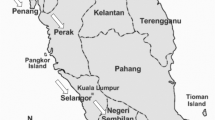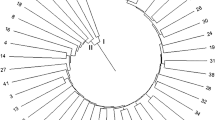Abstract
Twenty-five primer pairs developed from genomic simple sequence repeats (SSR) were compared with 25 expressed sequence tags (EST) SSRs to evaluate the efficiency of these two sets of primers using 59 sugarcane genetic stocks. The mean polymorphism information content (PIC) of genomic SSR was higher (0.72) compared to the PIC value recorded by EST-SSR marker (0.62). The relatively low level of polymorphism in EST-SSR markers may be due to the location of these markers in more conserved and expressed sequences compared to genomic sequences which are spread throughout the genome. Dendrogram based on the genomic SSR and EST-SSR marker data showed differences in grouping of genotypes. A total of 59 sugarcane accessions were grouped into 6 and 4 clusters using genomic SSR and EST-SSR, respectively. The highly efficient genomic SSR could subcluster the genotypes of some of the clusters formed by EST-SSR markers. The difference in dendrogram observed was probably due to the variation in number of markers produced by genomic SSR and EST-SSR and different portion of genome amplified by both the markers. The combined dendrogram (genomic SSR and EST-SSR) more clearly showed the genetic relationship among the sugarcane genotypes by forming four clusters. The mean genetic similarity (GS) value obtained using EST-SSR among 59 sugarcane accessions was 0.70, whereas the mean GS obtained using genomic SSR was 0.63. Although relatively lower level of polymorphism was displayed by the EST-SSR markers, genetic diversity shown by the EST-SSR was found to be promising as they were functional marker. High level of PIC and low genetic similarity values of genomic SSR may be more useful in DNA fingerprinting, selection of true hybrids, identification of variety specific markers and genetic diversity analysis. Identification of diverse parents based on cluster analysis can be effectively done with EST-SSR as the genetic similarity estimates are based on functional attributes related to morphological/agronomical traits.



Similar content being viewed by others
References
Ahmad A, Wang JD, Pan YB, Deng ZH, Chen ZW, Chen RK, Gao SJ (2017) Molecular identification and genetic diversity analysis of Chinese sugarcane (Saccharum spp. hybrids) varieties using SSR markers. Trop Plant Biol 10:194. https://doi.org/10.1007/s12042-017-9195-6
Ahmed MS, Gardezi SDA (2017) Molecular characterization of locally adopted sugarcane (Saccharum officinarum L.) varieties using microsatellite markers. The J Anim. Plant Sci 27(1):164–174
Alexandrov NN, Brover VV, Freidin S, Troukhan ME, Tatarinova TV, Zhang H, Swaller TJ, Lu YP, Bouck J, Flavell RB, Feldmann KA (2009) Insights into corn genes derived from large-scale cDNA sequencing. Plant Mol Biol 69:179–194
Alwala S, Suman A, Arro JA, Veremis JC, Kimbeng CA (2006) Target region amplification polymorphism (TRAP) for assessing genetic diversity in sugarcane germplasm collections. Crop Sci 46:448–455
Anderson JA, Churchill GA, Sutrique JE, Tanksley SD, Sorrells ME (1993) Optimizing parental selection for genetic linkage maps. Genome 36:181–186
Andru S, Pan YB, Thongthawee S, Burner DM, Kimbeng CA (2011) Genetic analysis of the sugarcane (Saccharum spp.) cultivar ‘LCP 85-384’.I. Linkage mapping using AFLP, SSR, and TRAP markers. Theor Appl Genet 123:77–93
Brasileiro BP, Marinho CD, Costa PMA, Moreira EFA, Peternelli LA, Barbosa MHP (2014) Genetic diversity in sugarcane varieties in Brazil based on the Ward-Modified Location Model clustering strategy. Genet Mol Res 13(1):1650–1660
Carson DL, Botha FC (2000) Preliminary analysis of expressed sequence tags for sugarcane. Crop Sci 40:1769–1779
Carson DL, Huckett BI, Botha FC, van Staden J (2002) Differential gene expression in sugarcane leaf and internodal tissues of varying maturity. S Afr J Bot 68(4):434–442
Casu R, Dimmock C, Thomas M, Bower N, Knight D, Grof C (2001) Genetic and expression profiling in sugarcane. Proc Int Soc Sugarcane Technol 24:626–627
Chen PH, Pan YB, Chen RK, Xu LP, Chen YQ (2009) SSR marker-based analysis of genetic relatedness among sugarcane cultivars (Saccharum spp. hybrids) from breeding programs in China and other countries. Sugar Tech 11(4):347–354
Cho YG, Ishii T, Temnykh S, Chen X, Lipovich L, McCouch SR, Park WD, Ayres N, Cartinhour S (2000) Diversity of microsatellites derived from genomic libraries and GenBank sequences in rice (Oryza sativa L.). Theor Appl Genet 100:713–722
Cordeiro GM, Taylor GO, Henry RJ (2000) Characterization of microsatellite markers from sugarcane (Saccharum spp.) a highly polyploidy species. Plant Sci 155:161–168
Cordeiro GM, Casu R, McIntyre CL, Manners JM, Henry RJ (2001) Microsatellite markers from sugarcane (Saccharum spp.) ESTs cross transferable to Erianthus and Sorghum. Plant Sci 160:1115–1123
Cordeiro GM, Pan YB, Henry RJ (2003) Sugarcane microsatellites for the assessment of genetic diversity in sugarcane germplasm. Plant Sci 165:181–189
Devarumath RM, Kalwade SB, Kawar PG, Sushir KV (2012) Assessment of genetic diversity in sugarcane germplasm using ISSR and SSR markers. Sugar Tech 14(4):334–344
dos Santos JM, Filho LSCD, Soriano ML, da Silva PP, Nascimento VX, de Souza Barbosa GV, Todaro AR, Neto CER, Almeida C (2012) Genetic diversity of the main progenitors of sugarcane from the RIDESA germplasm bank using SSR markers. Ind Crops Prod 40:145–150
Doyle JJ, Doyle JL (1987) A rapid DNA isolation procedure for small quantities of fresh leaf tissue. Phytochem Bull 19:11–15
Filho LSDG, Silva PP, Santos JM, Barbosa GVS, Ramalho-Neto CE, Soares L, Andrade JCF, Almeida C (2010) Genetic similarity among genotypes of sugarcane estimated by SSR and coefficient of parentage. Sugar Tech 12(2):145–149
Govindaraj P, Balasundaram N, Sharma TR, Bansal KC, Koundal KR, Singh NK (2005) Development of new STMS markers for sugarcane. Sugarcane Breeding Institute, Coimbatore, TamilNadu, India. http://www.nrcpb.org/content/development-new-stms-markers-sugarcane. Accessed 25 July, 2009
Govindaraj P, Sindhu P, Appunu C, Parthiban S, Senthilkumar S (2013) Genetic diversity analysis among interspecific and intergeneric hybrids of Saccharum spp. using STMS markers. Res Crops 14(3):915–920
Grivet L, Arruda P (2001) Sugarcane genomics: depicting the complex genome of an important tropical crop. Curr Opin Plant Biol 5:122–127
Hu J, Wang L, Li J (2011) Comparison of genomic SSR and EST-SSR markers for estimating genetic diversity in cucumber. Biol Plantarum 55(3):577–580
Kalwade SB, Devarumath RM (2014) Single strand conformation polymorphism of genomic and EST-SSRs marker and its utility in genetic evaluation of sugarcane. Physiol Mol Biol Plants 20(3):313–321
Kinoshita A, Nakamura Y, Sasaki E, Kyozuka J, Fukuda H, Sawa S (2007) Gain-of-function phenotypes of chemically synthetic CLAVATA3/ESR-related (CLE) peptides in Arabidopsis thaliana and Oryza sativa. Plant Cell Physiol 48(12):1821–1825
Lin X, Kaul S, Rounsley S, Shea TP, Benito MI, Town CD, Fujii CY, Mason T, Bowman CL, Barnstead M, Feldblyum TV, Buell CR, Ketchum KA, Lee J, Ronning CM, Koo HL, Moffat KS, Cronin LA, Shen M, Pai G, Aken SV, Umayam L, Tallon LJ, Gill JE, Adams MD, Carrera AJ, Creasy TH, Goodman HM, Somerville CR, Copenhaver GP, Preuss D, Nierman WC, White O, Eisen JA, Salzberg SL, Fraser CM, Venter JC (1999) Sequence and analysis of chromosome 2 of the plant Arabidopsis thaliana. Nature 16:761–768
Liu F, Xu W, Tan L, Xue Y, Sun C, Su Z (2008) Case study for identification of potentially indel-caused alternative expression isoforms in the rice subspecies japonica and indica by integrative genome analysis. Genomics 91(2):186–194
Marconi GT, Costa EA, Miranda HRCAN, Mancini MC, Silva CBC, Oliveira KM, Pinto LR, Mollinari M, Garcia AAF, Souza AP (2011) Functional markers for gene mapping and genetic diversity studies in sugarcane. BMC Res Notes 4:264
Oliveira KM, Pinto LR, Marconi TG, Margarido GRA, Pastina MM, Teixeira LHM (2007) Functional integrated genetic linkage map based on EST markers for a sugarcane (Saccharum spp.) commercial cross. Mol Breed 20:189–208
Oliveira KM, Pinto LR, Marconi TG, Mollinari M, Ulian EC, Chabregas SM, Falco MC, Burnquist W, Garcia AAF, Souza AP (2009) Characterization of new polymorphic functional markers for sugarcane. Genome 52:191–209
Pan YB (2006) Highly polymorphic microsatellite DNA markers for sugarcane germplasm evaluation and variety identity testing. Sugar Tech 8:246–256
Pashley CH, Ellis JR, McCauley DE, Burke JM (2006) EST database as a source for molecular markers: lessons from Helianthus. J Hered 97:381–388
Perera MF, Arias ME, Costilla D, Luque AC, Garcia MB, Romero CD, Racedo J, Ostengo S, Filippone MP, Cuenya MI, Castagnaro AP (2012) Genetic diversity assessment and genotype identification in sugarcane based on DNA markers and morphological traits. Euphytica 185:491–510
Pinto LR, Oliveira KM, Marconi T, Garcia AAF, Ulian EC (2006) Characterization of novel sugarcane expressed sequence tag microsatellites and their comparison with genomic SSRs. Plant Breed 125:378–384
Piperidis N, Jackson PA, D’Hont A, Besse P, Hoarau JY, Courtois B, Aitken KS, McIntyre CL (2008) Comparative genetics in sugarcane enables structured map enhancement and validation of marker-trait associations. Mol Breed 21:233–247
Raboin LM, Oliveira KM, Lecunff L, Telismart H, Roques D, Butterfield M, Hoarau JY, D‘Hont A (2006) Genetic mapping in sugarcane, a high polyploid, using bi-parental progeny: identification of a gene controlling stalk colour and a new rust resistance gene TAG. Theor Appl Genet 112:1382–1391
Racedo J, Gutiérrez L, Perera MF, Ostengo S, Pardo EM, Cuenya MI, Welin B, Castagnaro AP (2016) Genome-wide association mapping of quantitative traits in a breeding population of sugarcane. BMC Plant Biol 16:142
Roach BT (1972) Nobilization sugarcane. Proc Int Soc Sugarcane Technol 14:206–216
Saravanakumar K, Govindaraj P, Appunu C, Senthilkumar S, Kumar Ravinder (2014) Analysis of genetic diversity in high biomass producing sugarcane hybrids (Saccharum spp. complex) using RAPD and STMS markers. Indian J Biotechnol 13:214–220
Singh RK, Srivastava S, Singh SP, Sharma ML, Mohapatra T, Singh NK, Singh SB (2008) Identification of new microsatellite DNA markers for sugar and related traits in sugarcane. Sugar Tech 10(4):327–333
Singh RK, Singh RB, Singh SP, Sharma ML (2011) Identification of sugarcane microsatellites associated to sugar content in sugarcane and transferability to other cereal genomes. Euphytica 182:335–354
Singh RK, Jena SN, Khan S, Yadav S, Banarjee N, Raghuvanshi D, Bhardwaj V, Dattamajumder SK, Kapur R, Solomon S, Swapna M, Srivastava S, Tyagi AK (2013) Development, cross-species/genera transferability of novel EST-SSR markers and their utility in revealing population structure and genetic diversity in sugarcane. Gene 524:309–329
Singh RB, Singh B, Singh RK (2015) Development of microsatellite (SSRs) markers and evaluation of genetic variability within sugarcane commercial varieties (Saccharum spp. hybrids). Int J Adv Res 3(12):700–708
Singh P, Singh SP, Tiwari AK, Sharma BL (2017) Genetic diversity of sugarcane hybrid cultivars by RAPD markers. 3 Biotech 7:222. https://doi.org/10.1007/s13205-017-0855-x
Soderlund C, Descour A, Kudrna D, Bomhoff M, Boyd L, Currie J, Angelova A, Collura K, Wissotski M, Ashley E, Morrow D, Fernandes J, Walbot V, Yu Y (2009) Sequencing, mapping, and analysis of 27,455 maize full-length cDNAs. PLoS Genet 5(11):e1000740
Tew TL, Pan Y (2010) Microsatellite (SSR) Marker-based paternity analysis of a seven-parent poly crosses in sugarcane. Crop Sci 50:1401–1408
Varshney RK, Graner A, Sorrells MW (2005) Genic microsatellite markers in plants: features and applications. Trends Biotechnol 23:48–55
Wen MF, Wang HY, Xia ZQ, Zou ML, Lu C, Wang WQ (2010) Development of EST-SSR and genomic-SSR markers to assess genetic diversity in Jatropha curcas L. BMC Res Notes 3:42–50
Yilmaz A, Nishiyama MY, Fuentes BG, Souza GM, Janies D, Gray J, Grotewold E (2009) GRASSIUS: a Platform for comparative regulatory genomics across the grasses. Plant Physiol 149(1):171–180
You Q, Pan YB, Xu LP, Gao SW, Wang QN, Su YC, Yang YQ, Wu QB, Zhou DG, Que YX (2016) Genetic diversity analysis of sugarcane germplasm based on fluorescence-labeled simple sequence repeat markers and a capillary electrophoresis-based genotyping platform. Sugar Tech 18(4):380–390
Acknowledgements
The authors are grateful to the Indian Council of Agricultural Research and the Sugarcane Breeding Institute, Coimbatore for the funding and infrastructure.
Author information
Authors and Affiliations
Contributions
Dr. P. Govindaraj designed the research, instrumental in conception of the work, provided a critical review of the article and valuable suggestions in the interpretation of data. Mr. S. Parthiban performed the lab and field experiments, analyzed the results and drafted the manuscript. Mr. S. Senthilkumar helped in field and lab experiments.
Corresponding author
Ethics declarations
Conflict of interest
The authors declare that they have no conflict of interests.
Electronic supplementary material
Below is the link to the electronic supplementary material.
Rights and permissions
About this article
Cite this article
Parthiban, S., Govindaraj, P. & Senthilkumar, S. Comparison of relative efficiency of genomic SSR and EST-SSR markers in estimating genetic diversity in sugarcane. 3 Biotech 8, 144 (2018). https://doi.org/10.1007/s13205-018-1172-8
Received:
Accepted:
Published:
DOI: https://doi.org/10.1007/s13205-018-1172-8




